For businesses wanting to increase their online visibility, having a thorough knowledge of SEO is essential. To maximize visibility, this post will outline the basics of SEO and how it can affect your website’s search engine rankings.
This blog post covers everything you need to know about SEO basics so let’s dive right in!
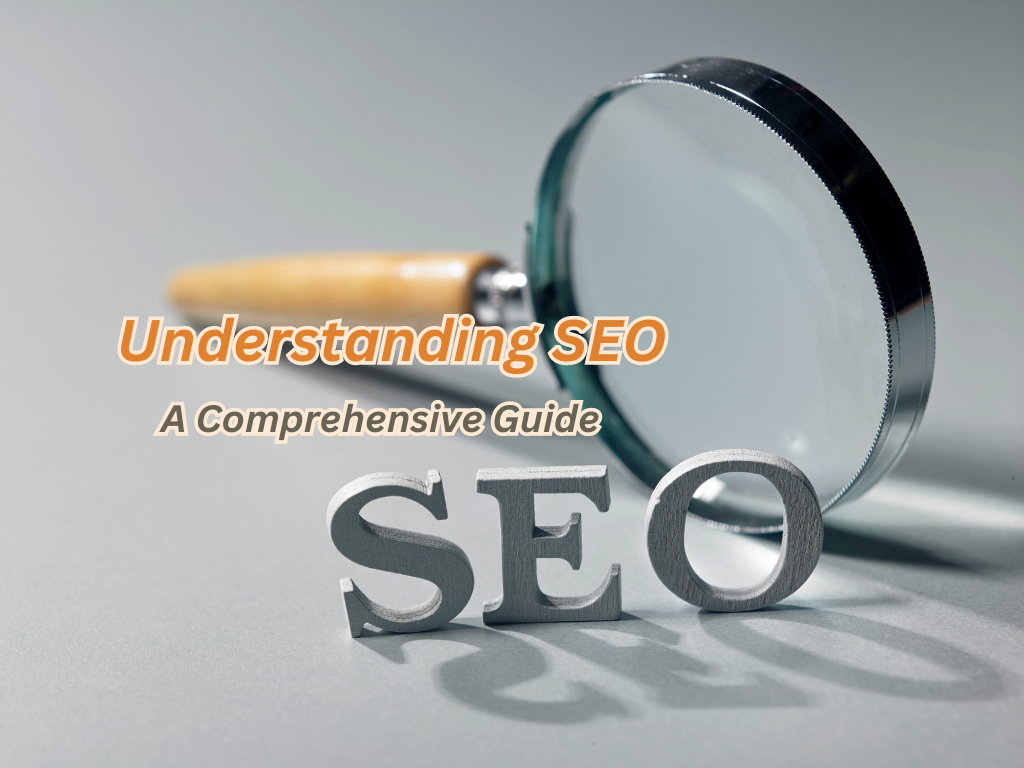
What is SEO?
SEO (Search Engine Optimization) is the process of increasing a website’s organic search engine traffic. It includes activities like keyword research, content development, link building, and technical assessments.
How Search Engines Work
Search engines are powerful tools that enable users to find the information they need quickly and easily.
They work by scanning through billions of web pages, indexing them according to their content, and then providing relevant results for any search query a user enters.
At the core of this process is an algorithm that determines what results to display for each search query. Google’s algorithm takes into account hundreds of factors when deciding which pages should appear in its SERPs (search engine result pages).
These include things like page titles, meta descriptions, keywords used on the page, backlinks from other websites, etc. The goal is always to provide the most relevant and useful results as quickly as possible.
Another important factor in how search engines work is crawling – essentially “reading” all the web pages out there so it can index them correctly.
This involves sending out automated bots called spiders or crawlers that scour every corner of the internet looking for new content or changes made to existing content.
Once these have been identified they are added to a database where they can be retrieved when someone searches for something related to them.
Finally, once all this data has been collected it needs organizing so that people can find what they’re looking for more easily – this is known as ranking or sorting algorithms which prioritize certain pieces of information over others based on various criteria such as relevance and popularity among other things.
This ensures that only high-quality sites show up at the top of SERPs while low-quality ones get pushed further down or excluded altogether depending on how well they meet certain standards set by Google and other major search engines like Bing and Yahoo!
Overall understanding how search engines work requires an appreciation not just for technology but also for human behavior; after all, it’s humans who decide what kind of content should rank higher than others!
Why Seo Focuses Mainly on Google

When it comes to search engine optimization (SEO), Google is king. With a 92% share of the global search engine market, it’s no wonder why SEO focuses mainly on Google.
It’s important to understand how and why this is so to maximize your website’s visibility online.
At the heart of any successful SEO strategy lies an understanding of Google’s algorithm.
This algorithm determines which websites appear at the top of a user’s search results based on relevance and quality signals such as content, backlinks, page speed, etc.
By optimizing for these factors you can ensure that your website appears higher up in the rankings when users enter relevant keywords into their searches.
Another reason why SEO focuses mainly on Google is that they prioritize user experience above all else.
They want users to find what they are looking for quickly and easily without having to sift through irrelevant or low-quality content.
To achieve this goal, they use various ranking factors such as page load time, mobile friendliness, and structured data markup which all contribute towards creating a better overall user experience for those searching with their platform.
Finally, there is also intense competition among websites vying for top spots in organic search results due to limited space available at the top positions – typically only 10 listings per page are displayed prominently within SERPs (Search Engine Results Pages).
As such businesses must be aware of their competitors’ strategies to stay ahead of them by making sure their sites have been optimized properly according to best practices laid out by Google themselves if they wish to remain competitive online.
In conclusion, SEO largely revolves around optimizing for what works best with Google since it holds such a large portion of the global market share when it comes down to web searches – not just from an algorithmic standpoint but also from a user experience perspective too – meaning businesses need to keep up with changes made by them if they wish to remain competitive online .
Seo Strategies: Black Hat Vs. White Hat
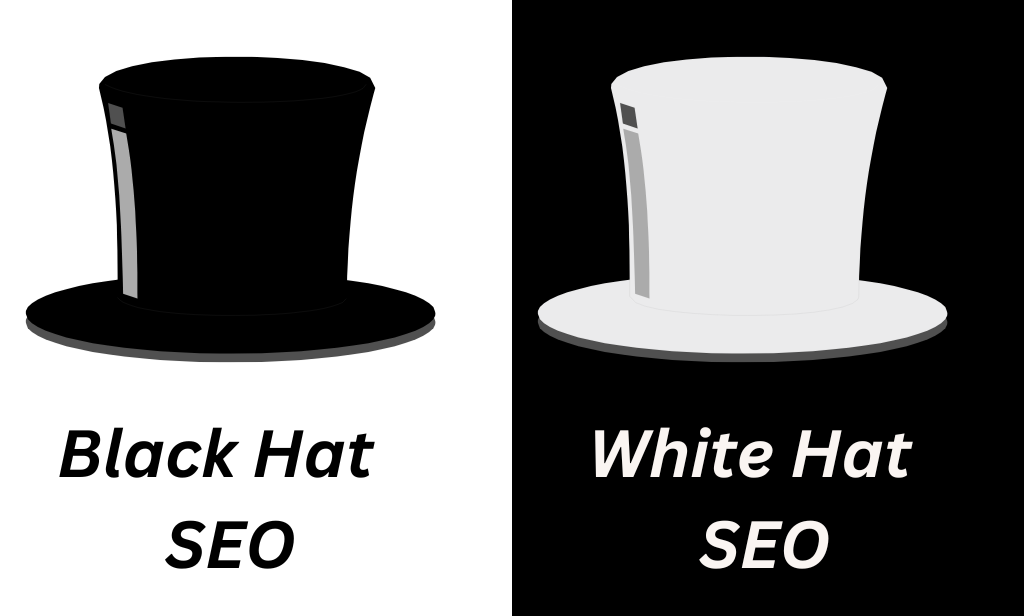
When it comes to SEO strategies, there are two distinct approaches: Black hat and white hat. Black hat techniques involve using tactics that go against search engine guidelines to gain a competitive advantage. White hat techniques focus on following the rules and creating content that is valuable for users.
Duplicate content is one of the most common black-hat tactics used by unscrupulous webmasters. It involves copying existing effective content from other pages in an attempt to rank higher for certain keywords.
Google penalizes sites that do this, as it can lead to keyword cannibalization where multiple pages from the same site compete against each other for rankings.
Another example of black-hat SEO is invisible text or keyword stuffing, which involves adding a ton of keywords at the bottom of articles but making them the same color as the background so they’re not visible to readers but still picked up by search engines.
Cloaking and redirecting are also considered unethical practices since they manipulate search engine results without providing any real value for users.
Finally, buying links is another form of manipulation often employed by those who want quick success with their SEO efforts without putting any real work or effort into building organic traffic over time through quality content creation and link-building activities such as guest blogging or influencer outreach campaigns.
In contrast, white-hat SEO focuses on following best practices set out by major search engines like Google and Bing to provide users with relevant information when they perform searches online.
This includes optimizing page titles, meta descriptions, headings tags (H1s), and image alt tags; creating high-quality original content; improving website speed; leveraging social media platforms; conducting keyword research; utilizing internal linking structures; developing backlinks from authoritative sources; optimizing images & videos properly, etc., all while adhering strictly to ethical standards set forth by these major players in digital marketing space.
All these activities help create a better user experience overall which leads directly toward improved rankings within SERPs (Search Engine Results Pages).
Types of Seo
Search engine optimization (SEO) is the process of optimizing a website to improve its visibility in search engines and drive more organic traffic. There are three main types of SEO: on-site, off-site, and technical.
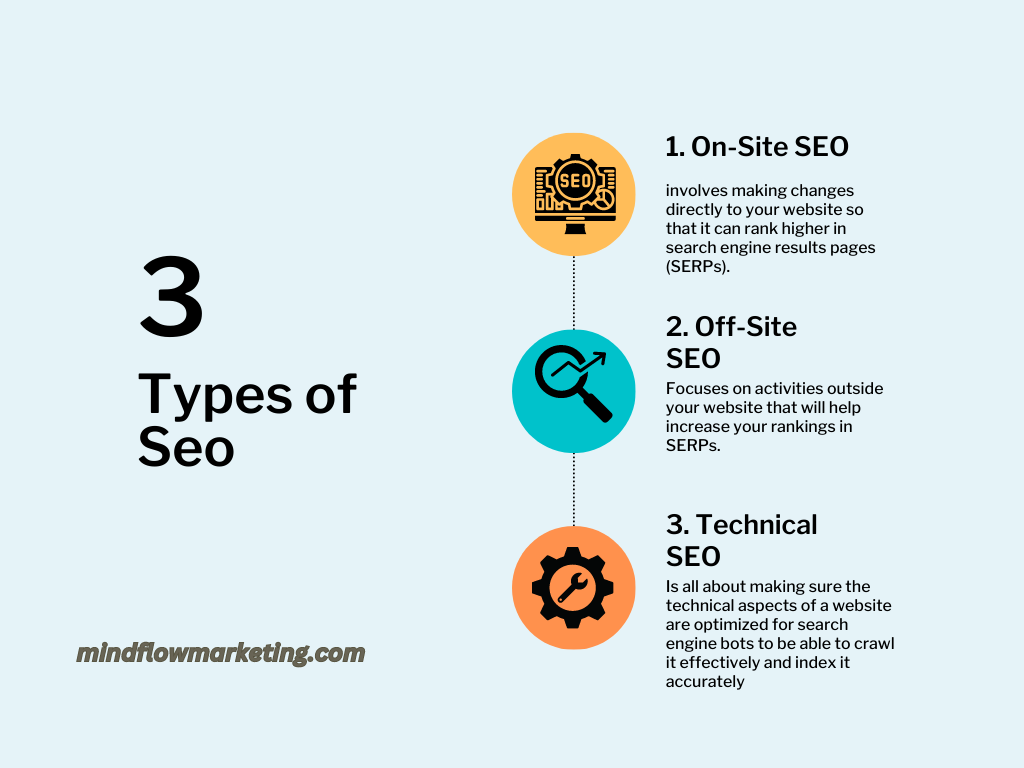
On-site SEO involves making changes directly to your website so that it can rank higher in search engine results pages (SERPs). This includes things like keyword research, content optimization, page titles and meta descriptions, internal linking structure, image alt tags, and other elements. It also includes improving user experience by making sure the site loads quickly and has a mobile-friendly design.
Off-site SEO focuses on activities outside your website that will help increase your rankings in SERPs. This includes link building – getting high-quality links from other websites pointing back to yours – as well as social media promotion and reputation management. These activities can have an impact on how visible you are online as well as how trustworthy Google sees you when ranking for certain keywords or phrases.
Technical SEO is all about making sure the technical aspects of a website are optimized for search engine bots to be able to crawl it effectively and index it accurately. This involves tasks such as generating an XML sitemap to facilitate navigation around the site; validating redirects; defining canonical URLs; integrating structured data markup like schema; enforcing HTTPS encryption protocols; optimizing page loading speed with Core Web Vitals criteria; evading intrusive interstitials (pop-ups); verifying robots directives through Robots Exclusion Protocol (REP); evaluating server response codes, among many other related activities about technical optimization.
Content

Content is one of the most important elements for successful search engine optimization (SEO). Content must be fresh, relevant to user intent, and actionable to rank well.
Search engines prioritize content that is recent and up-to-date. This means regularly updating existing content as well as creating new content. For example, if you have an online store selling shoes, it’s important to update your product descriptions with the latest styles and trends.
Additionally, adding blog posts or articles about shoe trends can help keep your site current and give readers more reasons to visit your website.
When users type something into a search engine they are looking for specific information or products related to their query.
Your content must match what users are searching for so they can find what they need quickly and easily without having to sift through irrelevant results.
To do this effectively you should use keywords throughout your page titles, headings, body text, etc., that accurately reflect the topic of each page on your website – this will ensure that when someone searches using those terms they will find exactly what they were looking for on your site rather than being directed elsewhere.
The way you present information also plays an important role in SEO success; make sure all of the copy is easy to read by breaking up long paragraphs into shorter ones with plenty of white space between them; use bullet points where appropriate; include images and videos infographics etc.; highlight key words; add internal links within pages posts etc.
All these techniques make it easier for visitors to read through the material quickly while still providing valuable insights which encourage them to take further action such as signing up for newsletters or making purchases from ecommerce sites etc.
Keyword Research and Selection
It helps you understand the intent behind what people are searching for, as well as how competitive certain keywords are. Knowing this information can help you create content that will rank better in search engine results pages (SERPs). Additionally, keyword research can provide valuable insight into your target audience and help inform other aspects of your digital marketing strategy.
What Factors Should You Consider When Doing Keyword Research?
When doing keyword research, there are several factors to consider. First, it’s important to understand the intent behind a particular keyword or phrase. Are people looking for informational content or do they want to buy something?
Second, look at the competition level for each keyword – which sites already have high rankings and what kind of authority do they have?
Thirdly, consider whether a particular keyword aligns with your overall business goals and objectives – if not, then it may be best to focus on different terms instead.
Finally, make sure that any keywords you choose fit naturally within your website’s structure and page titles so that search engines can easily crawl them.
Site Architecture
Site architecture, also known as website structure, refers to the organization and hierarchy of a website’s pages and content. It is an important aspect of SEO because it can affect how search engines crawl and index your site, as well as how users navigate and interact with your content.
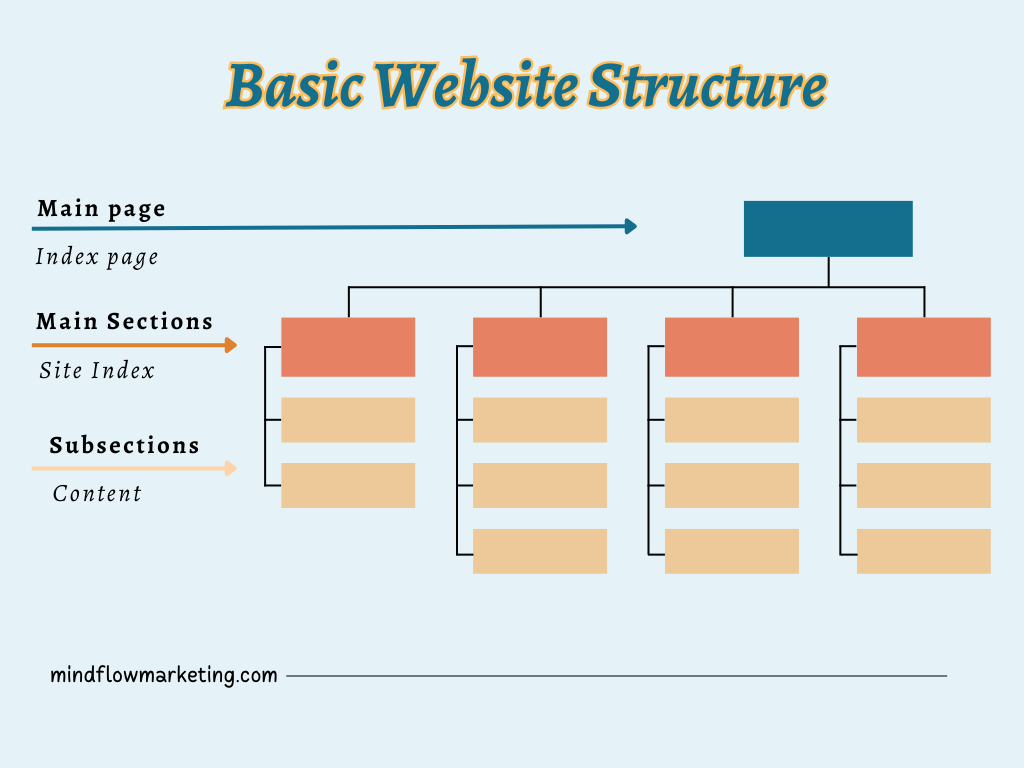
Here are some key considerations:
It’s important to ensure your website is built in a way that makes it easy for search engine crawlers to access and index all of its pages. This means having an organized, logical structure that allows the bots to easily navigate from page to page. It also helps if you create a sitemap with a plugin or online generator so Google can find all the pages on your site quickly.
When it comes to SEO, crawlability is key. Search engines use “spiders” (or bots) which are automated programs designed to crawl websites and collect data about them – such as content, links, images, etc – for them to be indexed by search engines like Google and Bing. The better your website architecture is set up, the more likely these spiders will be able to find their way around your site without any problems. If they have difficulty navigating through your website due to poor design or broken links then this could negatively affect how well you rank in SERPs (Search Engine Results Pages).
With mobile searches now accounting for over half of all web traffic worldwide your website must be optimized for mobile devices too; otherwise, you risk losing out on potential customers who may not be able to visit certain parts of your site due to its unresponsiveness or slow loading times when accessed via smartphone or tablet device. Make sure you test out different versions of both desktop and mobile designs before launching anything live.
Links
Links are one of the most important ranking factors Google has for you, but it’s easy to get wrong if you don’t understand how to do it right. The key is to take a long-term approach and build links that are relevant and valuable in exchange for a link.
When building links, relevancy is key. Google expects the links pointing to your site to be related to your niche or industry. Bulk purchasing low-cost links won’t help because they aren’t likely going to be relevant or useful.
Avoid paying for links as this will put you on Google’s radar and could result in penalties against your website rankings. If you come across sites offering guest posts in exchange for payment, steer clear – these can easily be identified by doing a “site
write for us” search online.
Link building should always involve some kind of value exchange; make sure that when writing guest posts on other websites, there’s something beneficial coming back from them too (e.g., traffic). This way, Google will reward those who provide genuine value with higher rankings instead of those who simply buy their way up the ladder.
Trust
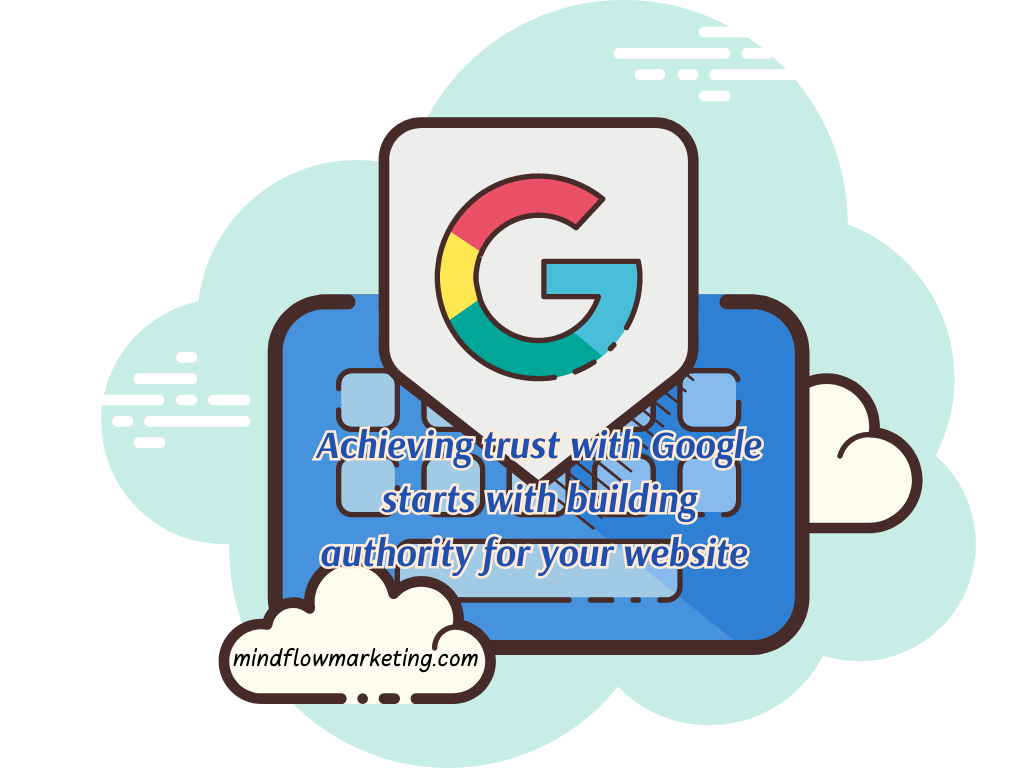
Achieving trust with Google starts with building authority for your website. You can use the tool from Ahrefs to check your website’s authority on a scale of 1-100 and also look at domain and page authority numbers from Moz which is based on 100 as well. Anything over 50-60 is considered high while 80-90 is often the highest in a particular industry.
Your bounce rate measures how many people view only one page on your site before leaving again so it’s important to make sure you have quality content that provides what the reader expects quickly when they land on your page to keep them engaged longer and show Google that your site is topically relevant. This includes loading times being fast as well as having good visuals such as videos or images that draw readers in further into exploring more pages of the website.
Establishing trust doesn’t happen overnight; it takes time for Google to see if you’re legit or not which means having an older domain age helps too since it shows stability and reliability over time rather than a new website without any history yet behind it which makes gaining trust harder initially until proven otherwise through other aspects like quality backlinks or authoritative metrics mentioned earlier etc
Google’s E-A-T Guidelines
Google’s E-A-T guidelines, which stand for Expertise, Authoritativeness, and Trustworthiness, are a set of standards used by Google to evaluate the quality and relevance of content on a website. E-A-T is particularly important for websites that provide content related to health, finance, and other important topics that can impact people’s well-being or finances.
Here are some key considerations for each of the E-A-T components:
E-A-T stands for Expertise, Authoritativeness, and Trustworthiness. It’s a concept Google uses to evaluate the quality of content on web pages. In other words, it helps Google determine if a page provides useful information that readers can trust. When creating content, you should always strive to create pages with high E-A-T scores.
Google expects all content creators to have some level of expertise in their field before they publish any material online. This means having an understanding of the subject matter as well as being able to provide accurate information about it. To increase your E-A-T score, make sure your website features expertly written articles from people who know what they’re talking about and can back up their claims with facts or evidence from reliable sources.
To be seen as authoritative by Google requires more than just expertise; it also requires credibility and recognition in the field you’re writing about. If possible, include quotes or endorsements from experts or industry leaders in your article so readers know that your content has been verified by someone knowledgeable in the topic area. Additionally, link out to reputable websites whenever appropriate so readers can easily find additional resources related to the topic at hand if needed.
Finally, trustworthiness refers not only to accuracy but also transparency when presenting information online—this includes disclosing any affiliations between yourself and companies mentioned within an article (if applicable). Additionally, avoid making any false promises or exaggerated claims since this could lead visitors away from trusting your brand altogether over time due to broken expectations caused by misleading statements made previously onsite online somewhere else
How to Monitor &Track Seo Results
Monitoring and tracking SEO results is important to ensure that your optimization efforts are producing positive outcomes. Here are some ways to monitor and track SEO results:
#1. Monitor Traffic
The most basic and important metric for tracking SEO success is website traffic. To monitor your website’s performance, you need to keep an eye on the number of visits, page views, and time spent on each page. By understanding how people interact with your site, you can make adjustments that will improve user experience and increase organic search visibility.
#2. Track Engagement
Engagement metrics measure how users interact with content on a web page or blog post; this includes bounce rate (how quickly someone leaves a page), average session duration (how long someone stays on a page), click-through rate (CTR) from SERPs to pages within your site, etc. Tracking engagement metrics helps you identify which pieces of content are resonating with readers so that you can optimize them further for better rankings in the future.
#3. Analyze Links
You should also track broken links since these can hurt your ranking significantly if left unchecked for too long.
Should You Outsource Seo or Keep it In-House?

Deciding whether to outsource SEO or keep it in-house depends on several factors such as budget, expertise, and the scope of your SEO needs. Here are some pros and cons of outsourcing SEO versus keeping it in-house:
Outsourcing your SEO can be a great way to get the job done quickly and efficiently. It’s also much more cost-effective than hiring an in-house team. You won’t have to worry about training new employees or dealing with any turnover issues; instead, you can focus on getting the results you need without worrying about managing personnel.
Plus, since most outsourced services specialize in search engine optimization specifically, they will often have access to specialized tools and techniques that may not be available to your internal team. This could result in faster improvements in rankings and traffic than if you had gone it alone.
One downside of outsourcing is that you lose some control over the process. Depending on how involved your agency is with your business objectives and goals, there may be times when their recommendations don’t align with what would best serve your company’s needs.
Additionally, because these agencies are typically working for multiple clients at once (and sometimes across different industries), it can take longer for them to respond to requests or make changes as needed due to their workloads being spread thin across many projects at once.
Lastly, depending on the contract terms between yourself and the agency you hire for SEO work — such as length of agreement or exclusivity — there may be certain restrictions put into place that limit how quickly changes can occur within a given timeframe if something needs adjusting down the line.
FAQs about Understanding Search Engine Optimization
Conclusion
Grasping the fundamentals of search engine optimization is a key factor in any prosperous web-based enterprise. By optimizing your website for SEO, you can leverage the visibility and reach a broader audience. This includes understanding keywords and phrases, crafting content that is optimized for the web, improving site architecture with titles, descriptions, and URLs as well as utilizing link-building strategies to gain more traffic from Google algorithms updates. Armed with this knowledge, one can leverage the full potential of SEO to maximize visibility and reach.